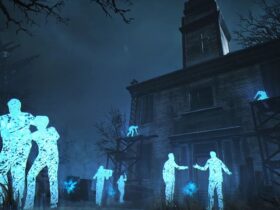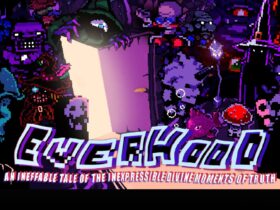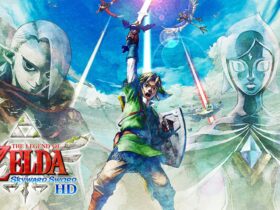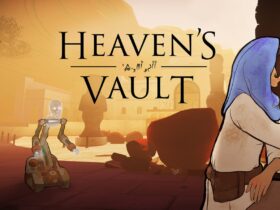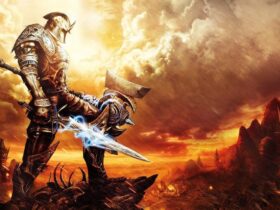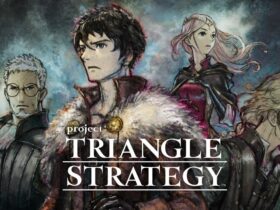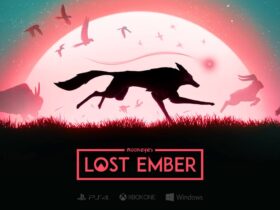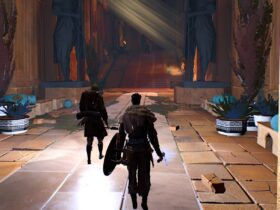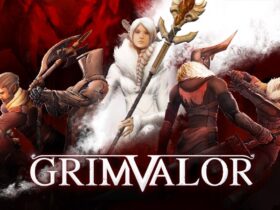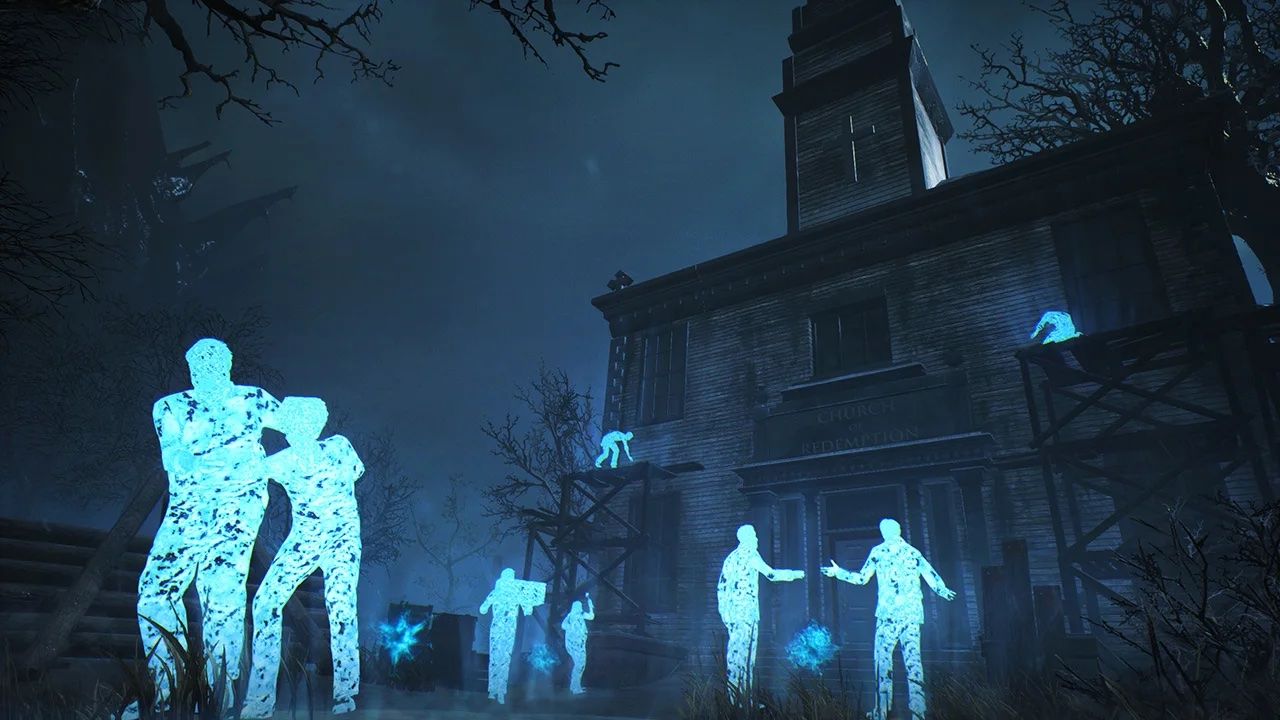Table of Contents:
Introduction: Halloween Night Is Lovecraft Night
Boo! Just in case you haven’t noticed, Halloween is right around the corner! And what would Halloween be without a nice, spooky story to lose sleep over?
But which spooky story should you choose? After all, you’re a bit spoiled for choice: there are countless spoooooktacular books, podcasts, movies, and yes, plenty of video games guaranteed to deprive you of what little sleep you shouldn’t be getting on Halloween anyway.
But what if your tastes in scary lean a bit more… eldritch? Cosmic? Unspeakable? What if slashers and even psychological horror make you snooze? What if you sneer at kiddie-grade “horror” that doesn’t invoke humankind’s oppressive, sanity-crushing, existentially-paralyzing insignificance?
And what if, along with that, you’re also so bored with horror that mere passive media just can’t give you the adrenaline fix that a fully interactive and immersive experience can? In other words… what if you’re a gamer and a Lovecraft fan?
Well, have no fear, my friend. For that’s where I come in. Muwahahahahaha!
Analysis: At the Pixels of Madness
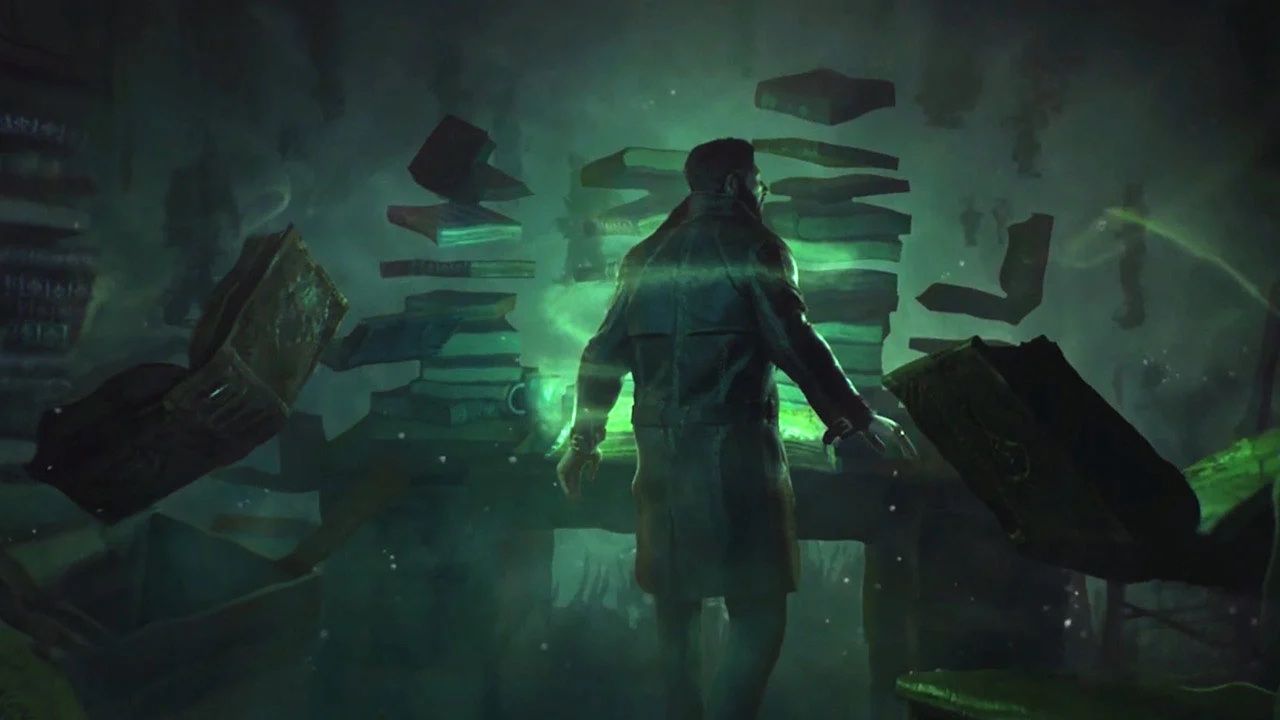
So, let me clarify something before we proceed. By “Lovecraft fan,” I mean a fan of H.P. Lovecraft‘s literary canon, not the man who wrote it. It’s not exactly a secret that Howard Phillip Lovecraft was notoriously racist and xenophobic, even for his time (1920s-30s America… which really says something). And unfortunately, these repulsive views bled into his work. To precisely what extent, and to what degree, is still a matter of debate. But it’s undeniable that he held very repugnant views on race.
Yet, despite his deplorable beliefs, Lovecraft’s tales continue to terrify and delight readers, even over 80 years after his death. His tales are grim, disquieting, and unapologetically bleak vignettes of despair, insanity, and futility, usually brought on by gazing into the horrifying, incomprehensible, and endless abyss of the cosmic void between the stars.
These stories left an indelible mark on modern fantasy and horror. Fantasy and horror powerhouses like Stephen King, Robert E. Howard, and George R.R. Martin cite Lovecraft as a significant (and sometimes primary) influence. They’ve inspired countless talented authors to write similar books, novellas, short stories, and fanfics. Each one adds to Lovecraft’s “Cthulhu Mythos”—his works’ primary universe—thus enriching and fleshing out its lore and themes. Some of these works even tackle Lovecraft’s racism, such as the excellent Lovecraft Country (and its new HBO adaptation).
However, video games based on Lovecraft are few and far between, and they’re often mediocre at best. Unlike board games and tabletop RPGs—which boast many excellent Lovecraftian titles—Lovecraft-inspired video games tend to be sloppy, dull, and unremarkable, appealing only to the most passionate Lovecraft fans. And even then, that’s not always a given. Why is that?
The Dunwich Hack
Lovecraftian movies, graphic novels, and other visual media often falter because Lovecraftian horror revolves around the unknowable, unspeakable, and indescribable. Naturally, this is quite tricky to portray visually. Lovecraft-inspired authors and podcasters don’t have to deal with this challenge, nor do tabletop RPG players and game masters. Nor can you simply omit these unexplainable elements, because fear of the unknown and unknowable is central to the genre. Remove it from a Lovecraftian work, and that work is no longer Lovecraftian.
You can imagine the headaches this causes visual storytellers trying adapt Lovecraft stories for the screen. How could you possibly portray something that’s—by definition—unportrayable? Especially when you can’t show a character’s inner thoughts, or use any of the several other storytelling techniques that authors use? Where would you even start?
And what’s worse? Even if you do find some inventive workaround—a “Dunwich Hack,” if you will—it’ll still be an imperfect solution. Such visual “hacks” will:
(a) inevitably compromise the truly unknowable nature of the horrors you’re portraying, and
(b) be one of a rather limited set of storytelling techniques (use of body horror and the uncanny valley are among the most common) you could use for this purpose.
Both of these factors will significantly blunt the fear they’d otherwise elicit.
On top of all this, Lovecraftian horror constitutes a niche subgenre, with an accordingly limited market size. Add all this together, and you start to understand why studios rarely greenlight Lovecraft adaptations. It’s also why the few out there tend to… well, suck (the 2019 adaptation of The Color Out of Space is a notable exception).
The Glitch Out of Space
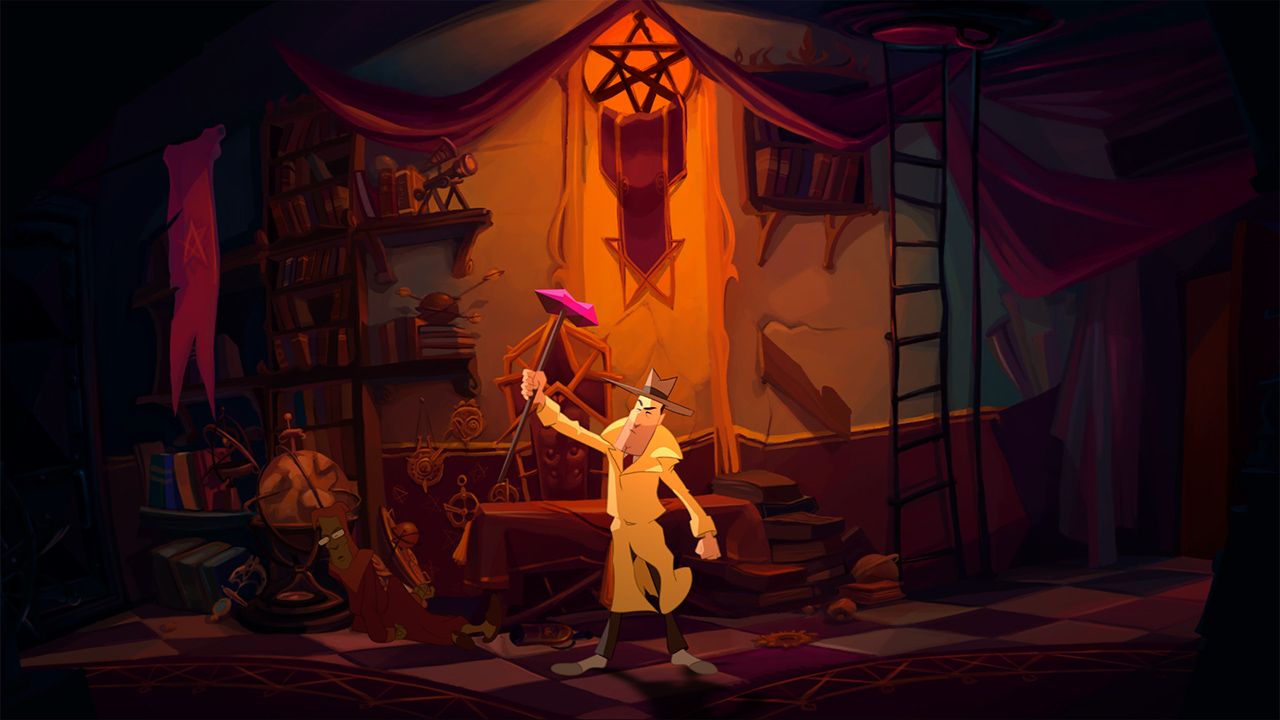
Those same obstacles similarly hamper Lovecraftian video games, along with some additional roadblocks on top of everything else. Games are arguably harder to make than movies (don’t @ me), with even higher barriers to entry for creators and a whole new element to consider: gameplay. This is a tough balance to nail even without trying to portray horrors too horrid to describe.
That said, gaming’s interactivity does provide an advantage. Thanks to the magic of mirror neurons, if a developer can elicit fear and dread in the player, they will feel this fear much more intensely than through any other medium. But again—how do you even portray something indescribable, let alone make it scary?
Put all this together, and you can see why making a Lovecraft game is such a daunting task. Some developers succeed, but sadly, most do not. And Lovecraftian video games tend to follow a sadly predictable pattern. Assuming a Lovecraftian game is even worth playing (and that’s far from a given), genre-savvy players can quickly infer a game’s nature—without ever touching a controller—based on how much it sticks to the genre’s established themes, tropes, and imagery.
Let’s start with games that mostly stick to convention.
The Curious Case of the Corny Cliché
Because this genre’s so hard to visually express, developers will often take the easy way out and fall back on established tropes, archetypes, imagery, and plots. This is so common, in fact, that “Lovecraftian” is almost shorthand for “cliché” at this point.
Protagonists are usually private investigators (often WW1 veterans) plagued by frequent and vivid nightmares, with antisocial and lonesome personalities, along with a dash of alcoholism. Developers almost always portray supposedly unfathomable cosmic horrors as oversized, demonic Squidwards, a visual tactic that’s long lost any of its frightful potential. Sanity mechanics—a great idea in and of itself, and one that actually was clever, novel, and scary—are quickly approaching this territory due to how ubiquitous they’ve become.
And to round everything off, the iconic Cthulhu inevitably shows up—despite there being several other Mythos deities to choose from, some of which might’ve fit the story better. With each appearance, this once-frightening, ineffable nightmare transforms ever-so-slightly into horror’s equivalent of a “knock-knock” joke. And his transformation is all but complete.
As a result, recognizably Lovecraftian games end up becoming trite and predictable slogs that strip the Mythos of its horrifying potency. The end result is dull, shallow, and—most significantly—not scary. So not scary, in fact, as to lend itself to parody (and the Mythos actually has spawned parodies). Being not scary is a horror story’s cardinal sin.
The Shovelware in the Darkness
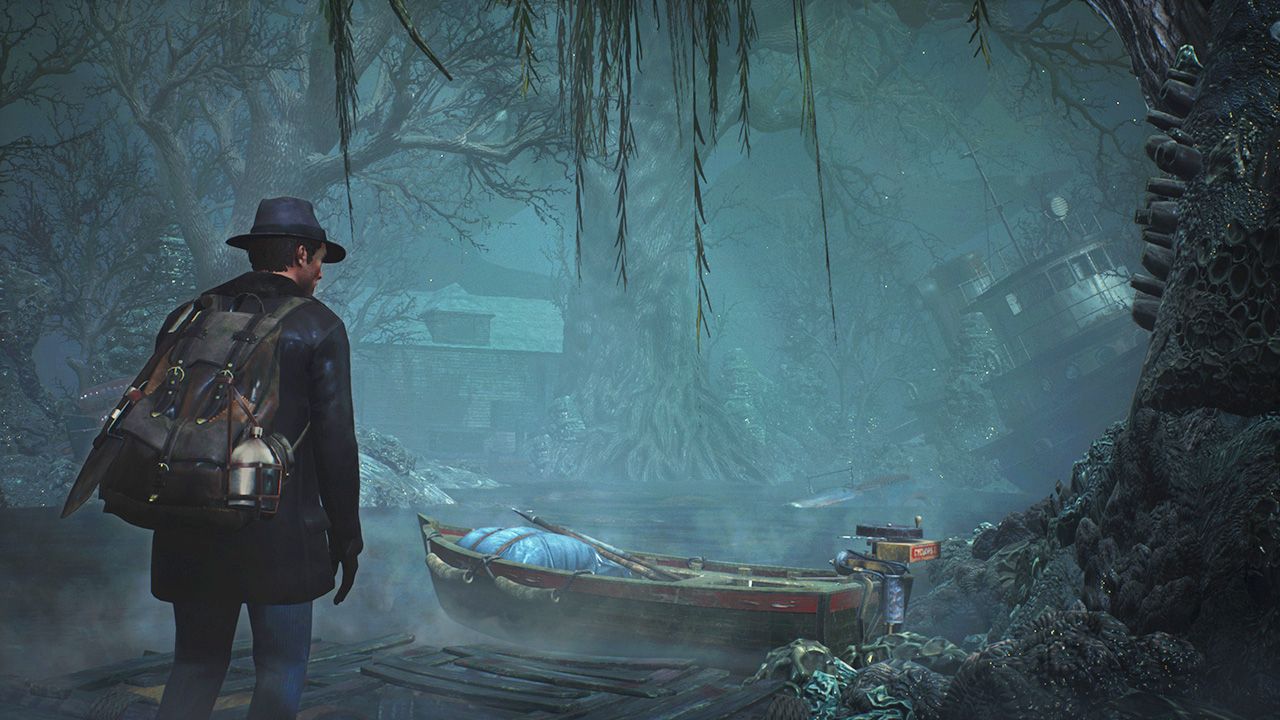
Unfortunately, taking the other approach—setting a game within the Mythos, but telling an original story while retaining the genre’s themes and specific flavor of horror—doesn’t guarantee success, either. While this approach can (and sometimes does) result in better Lovecraftian games, it also comes with its own pitfalls.
As with all genre fiction, audiences have certain expectations for Lovecraftian titles. Creators can only break with convention to a certain degree before their work stops fitting the genre altogether, alienating their audience as a result. And the more a story deviates from its genre’s conventions, the more contentious it becomes.
At the same time, audiences appreciate (and often demand) novelty and surprise. Too much of the same thing will eventally bore and disengage an audience. So the trick is for creators to craft stories that are fresh enough to delight their audiences while still meeting their expectations for the genre.
Obviously, this is easier said than done.
When executed well, these bold and innovative games offer fresh, compelling, and (most importantly) scary experiences within the Lovecraftian horror genre. They open entirely new avenues for exploring the Mythos. And they further enrich the genre by blending themes and conventions from other genres—storytelling genres (like comedy), gaming genres (like RPGs), or both. This broadens the title’s potential audience as well as its creative potential.
However, you still need to stick within the genre’s boundaries. And Lovecraftian horror is a very specific type of horror. Developers can (and do) bungle this to such a degree that their game ends up being Lovecraftian in name only. Or it stops being Lovecraftian at all. I’ve noticed that FPS games are particularly prone to this; after all, eldritch abominations really aren’t eldritch if you can fell them with a shotgun. And being killable robs these monstrosities of their frightful potency, completely defeating the point and purpose of creating a Lovecraftian horror game to begin with.
And if that’s the case, why even bother? Now, this doesn’t mean a game is bad. It might still be a good game—even an excellent game. But people buy Lovecraftian games because they want to play Lovecraftian games, not just any random game. And way too many games that describe themselves at “Lovecraftian” miserably fail at being Lovecraftian games, even if they succeed at being games more generally.
(SIDE NOTE: On the flip side, a lot of gaming’s best Lovecraftian horror experiences come from games that don’t describe themselves as Lovecraftian. Dead Space, Earthbound (spoilers in link), some Resident Evil titles, and Bloodborne all have telltale Lovecraftian elements, and to a too specific degree to be coincidental. The Lovecraftian elements may not be central to the game, and the developers may not acknowledge them—and may not even realize where they came from—but the influence is there. That should give you an idea of how influential Lovecraft’s work is.)
The Shadow Over My Sanity
This brings us to my mission for this piece: to help you determine which Lovecraftian games are worth booting up your Switch for—ideally under the covers, on Halloween night. Oh, don’t mention it; I only sacrificed my sanity for your convenience, no biggie. (You’re welcome!)
Reviews: Every Lovecraftian Switch Game, Ever
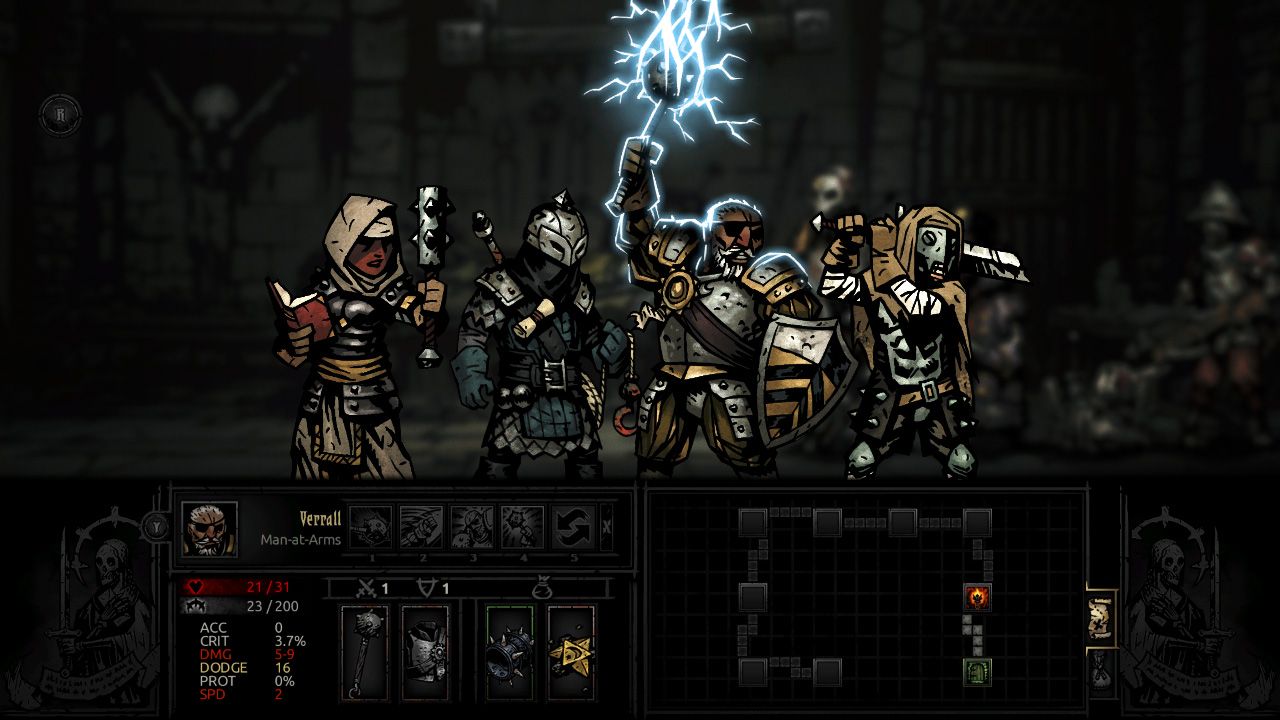
Yes, you read that right. I dived into EVERY. Single. Lovecraftian game on the Nintendo Switch. The ones I could find, anyway. And out of this maddening, indecipherable chaos, I’ve brought back summaries, recommendations, and numerical scores to help you find the perfect Lovecraftian game for Halloween.
Why the Switch? Because it’s the only console you can play under the covers on Halloween night!
Why didn’t I keep going, onto other platforms? Because I don’t have time to survey every single Lovecraftian game out there. Nor would I want to—just in case I wasn’t clear before, most Lovecraftian games are terrible. Playing all of them might actually drive me crazy, which… huh, I guess those games actually are scary and Lovecraftian after all. Touché, developers.
Anyway… are you ready? Well, get in losers! We’re plunging into the depths of everlasting, incomprehensible madness.
Review Contents:
- Call of Cthulhu
- Awakening of Cthulhu
- Gibbous
- Omen Exitio Plague
- The Innsmouth Case
- Lovecraft’s Untold Stories
- Darkest Dungeon
- Sunless Sea + Sunless Skies
- Tesla vs. Lovecraft
- The Last Door
- The Sinking City
- Conarium
- Cthulhu Saves Christmas
[NOTE: Rest easy, there are NO affiliate links in these reviews. Only the truth, the whole truth, and nothing but the truth about these games, so help me Kay. I don’t sleep at night for many reasons, but guilt over misleading my readers ain’t one of them.]
Call of Cthulhu

Genre: FPS (sort of)
Quick Review:
More an adaptation of the classic tabletop RPG than the novel itself, Call of Cthulhu might nevertheless be the most representative Lovecraftian game on the Switch, at least on the outside. This isn’t always for the better, however. In a vacuum, on its own merits, divorced of context or comparisons to the rest of the genre, this game is… fine. That’s it. Not a terrible game, but not a great one, either.
As a game, Call of Cthulhu has many flaws. It suffers from linear, shallow, and often clunky gameplay, for instance. But as a Lovecraftian game, it becomes much easier to recommend. Its story and atmosphere hit all the right notes. And while the game leans almost entirely into the genre’s most established and well-trodden tropes without adding anything new, this isn’t at all uncommon amongst Lovecraft-inspired games. And, ironically, its fealty to genre convention is arguably Call of Cthulhu’s biggest strength.
How so? Well, the game implants itself so firmly in the Mythos that it’s practically the “purest” Lovecraftian game on the market. As such, it’s a near-perfect introduction for Lovecraft neophytes. At the same time, its gameplay is simple and easy enough for non-gaming Lovecraft diehards to experience and enjoy.
Score: 7 out of 10
Awakening of Cthulhu
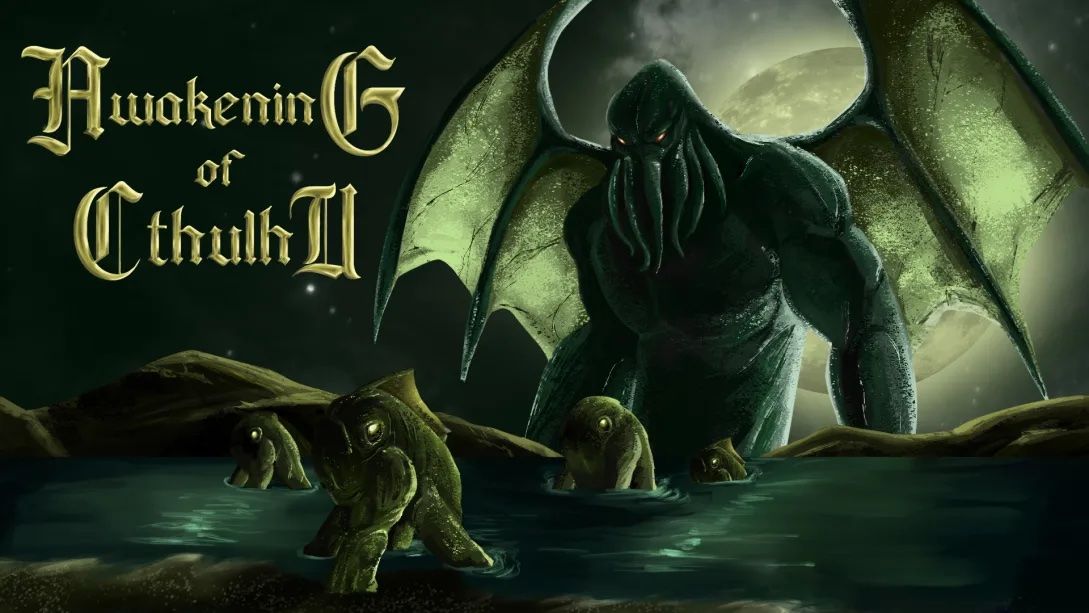
eShop Purchase Link [Ed: NOPE]
Genre: Platformer? ’00s Free Browser/Flash Game Hot Doo-Doo Butter Garbage
Quick Review:
Wow, just… wow. I mean… what the hell is this blasphemy?! This is a “game” only under the loosest, most generous definition. Awakening of Cthulhu is totally unplayable. Janky controls, janky animations, lazy low-res pixel graphics, no story or writing, and it doesn’t even have a pause menu! Fortunately, but even more insultingly, the whole ordeal’s over in under five minutes. And they first priced this turd at $11.99?! Most vaporware is more robust than this.
I’m entirely convinced is a cash grab by the developers. People are so starved for Lovecraftian games, the devs (correctly) assumed they could slap Cthulhu onto the emptiest, buggiest, and shittiest non-game ever committed to code, and desperate Lovecraft gamers would still buy it.
Well, fear not! For it is my duty to protect you from such a wretched fate as playing this “game.” This schlock is horrifying, not because the game’s at all scary (a box full of kittens riding a unicorn on a rainbow is scarier than this), but purely on account of how insultingly bad it is. This is greed and incompetence made manifest, and visions of its mediocrity will haunt my dreams until the moment I die (and even then, I’m not entirely sure). Curiosity is NOT your friend here. Stay far, far away! It’s too late for me, but you can still save yourself! And Nintendo, please stop letting sloppy, cash-grabbing shovelware like this piece of crap onto the eShop!
Score: 1/10 0/10 -1,000,000 out of 10
Gibbous: A Cthulhu Adventure
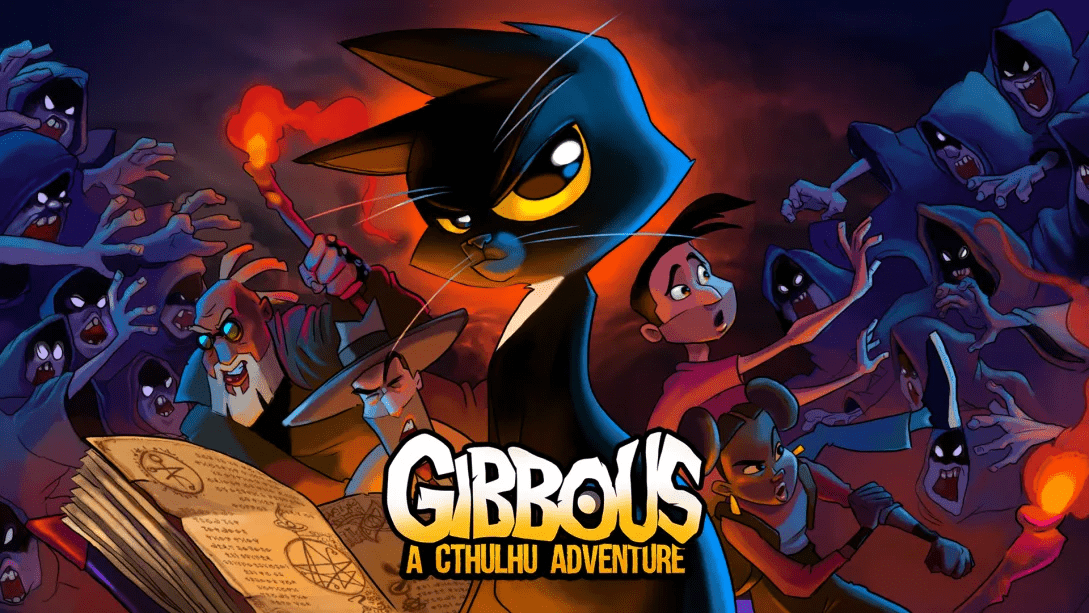
Genre: Point-And-Click Adventure
Quick Review:
Gibbous is an uncharacteristically (for a Lovecraftian title) colorful, bright, and lighthearted title that’s equal parts parody and homage. This is a point-and-click adventure, for better and for worse. Which means no action, no fail states, plodding pacing, and—proper to the adventure genre—puzzles that are either ludicrously straightforward or unreasonably obtuse (with no in-between).
Still, if you enjoy adventure games (or can at least tolerate their stubbornly anachronistic shortfalls), this game’s got plenty going for it. Its endearingly colorful and cartoony art style perfectly matches Gibbous’ lighter tone and is dripping with charm. The game’s writing and story are similarly superb, sharply lampshading Lovecraft’s most-read stories and most enduring conventions while serving up plenty of originality of its own.
But even these positives have shortcomings. While usually decent—and occasionally, even good—the game’s voice acting severely falters at times. The cat’s voice, for example, is far too monotone—and the tone itself is downright irritating. Relatedly, speaking animations are noticeably out of sync with their recorded lines. I sense that budgetary reasons are behind this, but it’s still distracting and annoying—to the point of breaking immersion. And so I must call it out.
Regardless, these flaws—noticeable as they are—don’t significantly detract from the experience. Gibbous’ visuals, humor, and story more than compensate for its weaknesses. And for those familiar with the Mythos, this game comes chock full of deep references and absolutely shines as a fun, funny, and affectionate send-up of Lovecraft’s literary canon.
Score: 8 out of 10
Omen Exitio Plague
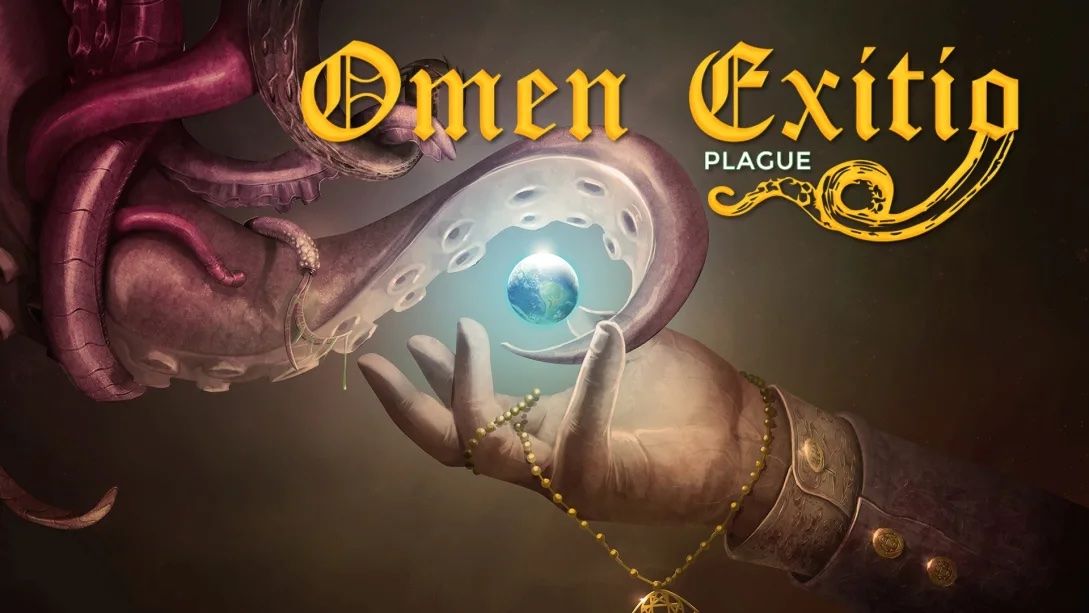
Genre: Visual Novel
Quick Review:
This one’s literally a visual novel—as in, it’s a book on screen, where the entirely text-based Omen Exitio Plague plays out. The challenge comes from making the right choices so you can earn a happy ending—or even reach the ending at all.
Now, I realize some gamers will take deep offense to my adding this game to this list. “Oh, those aren’t real games,” they’ll huff and puff. Well, it’s their loss—for despite it having no animation and nothing but penciled sketches to supplement the text, Omen Exitio Plague is easily the most terrifying Lovecraftian game on the eShop.
This game perfectly illustrates what’s possible when developers and storytellers try out new things within a genre’s established conventions. Existing fans will appreciate the references to the Mythos, but the story remains original and self-contained enough for Lovecraft newcomers to enjoy and follow the story. If anything, the game could’ve stuck out even further on its own. But even in its current form, I appreciate how Omen Exitio Plague explores some of the Mythos’ other, less-examined lore. And it doesn’t try to shoehorn Cthulhu into the story.
To sum it all up: play this game! If it’s not enough of a “real” game for you, then 1) grow up, and 2) treat it as a book, then. But whatever you do, don’t play late at night… or with the lights out…
Ah, crap. That’s exactly what you’re going to do, isn’t it?
Score: 9 out of 10
The Innsmouth Case
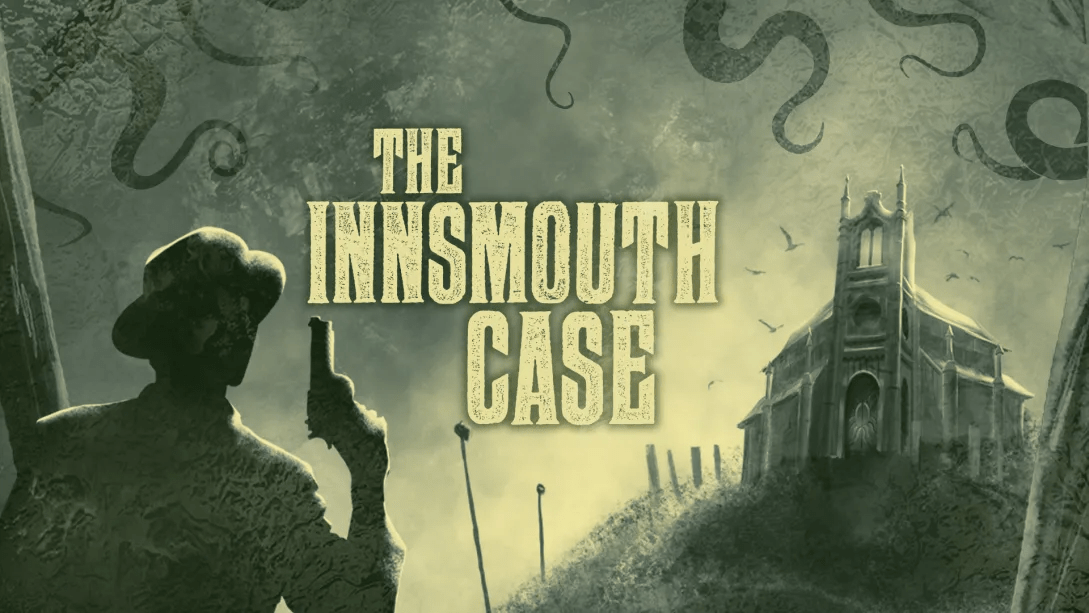
Genre: Visual Novel
Quick Review:
Another visual novel in the same vein as Omen Exitio Plague, The Innsmouth Case shares plenty in common with that game. Both are entirely text-based, choose-your-own-adventure-esque games that feel more like reading a book than playing a game (because that’s basically what you’re doing). And as with Omen Exitio Plague, I don’t mean that as a put-down, as both games are excellent and well worth your time. However, The Innsmouth Case differs in some pretty significant ways.
Unlike Omen Exitio Plague, which plays Lovecraftian horror entirely straight (and terrifyingly so), The Innsmouth Case is markedly lighter in tone. In this sense, one can compare it to Gibbous’ similarly irreverent-yet-reverential blend of comedy and Lovecraftian horror. Unlike Gibbous, however, The Innsmouth Case—while full of hilarious, lighthearted moments—actually features some legitimately scary and unsettling moments.
Also, you can die in this game—and you will die, a lot. But this works in The Innsmouth Case’s favor, as you’ll have fun uncovering all its different paths, chapters, and endings. You can also skip ahead or behind to chapters you’ve already played, so you don’t have to play the opening chapter each time you die. Trying out different options, and seeing where they get you, creates most of the game’s fun factor. And it certainly helps that The Innsmouth Case‘s has such magnificent writing.
The Innsmouth Case pairs colorful, animated illustrations with eerie background music to supplement the text and create a suitably eerie atmosphere. The images themselves, like the text, run the gamut from bright and flavorful to dark and unsettling, making this game a genuinely visual novel.
I heartily recommend The Innsmouth Case, but with one major caveat: it clearly assumes you’ve read Lovecraft’s stories, particularly The Shadow Over Innsmouth. This goes beyond referential easter eggs (although there are plenty of those), and even includes major plot points.
So if you’re a Lovecraft noob, you may struggle to figure out what’s even going on. So you might want to read The Shadow Over Innsmouth before you pick this one up. Or, you know… just read it anyway, so you can finally call yourself a real horror fan.
Score: 8 out of 10
Lovecraft’s Untold Stories

Genre: Roguelike
Quick Review:
This one showed plenty of promise, but I lost almost all interest after the first level. Lovecraft’s Untold Stories, as a whole, is a good, well-thought-out, and actually Lovecraftian game. It successfully elicits dread, which places it higher than 90% of the world’s Lovecraftian games. Its narrative, setting, protagonist, and enemies are all thematically appropriate. It includes all the prerequisite (if cliche) Lovecraftian elements like cultists and tentacled monstrosities, but it doesn’t stop there—it understands that “Lovecraftian” is about fear, not aesthetics. It’s mechanically solid, with a decent character progression system and every Lovecraft games’ required sanity mechanic. Lovecraft’s Untold Stories has a lot of potential here, and it the Steam reviews are anything to go by, plenty of players love and enjoy it.
It just isn’t my cup of tea.
Lovecraft’s Untold Stories is a roguelike, so it’s already facing an uphill battle for my attention. It’s not that I don’t like all roguelikes, but far too many of the genre’s essential conventions just don’t vibe with my playstyle. And sure enough, like most roguelikes I’ve played, Lovecraft’s Untold Stories quickly became far too much of a grind for my tastes. And it’s not like this could be fixed—roguelikes are supposed to be grindy. Any many players love that about them. Just not me.
Ultimately, this was not a game I enjoyed, nor would I recommend to someone with similar tastes. On the other hand, if you’re into roguelikes and relish the genre’s inherent challenge and grind, you could do far worse than Lovecraft’s Untold Stories.
Score: 6.5 out of 10
Darkest Dungeon
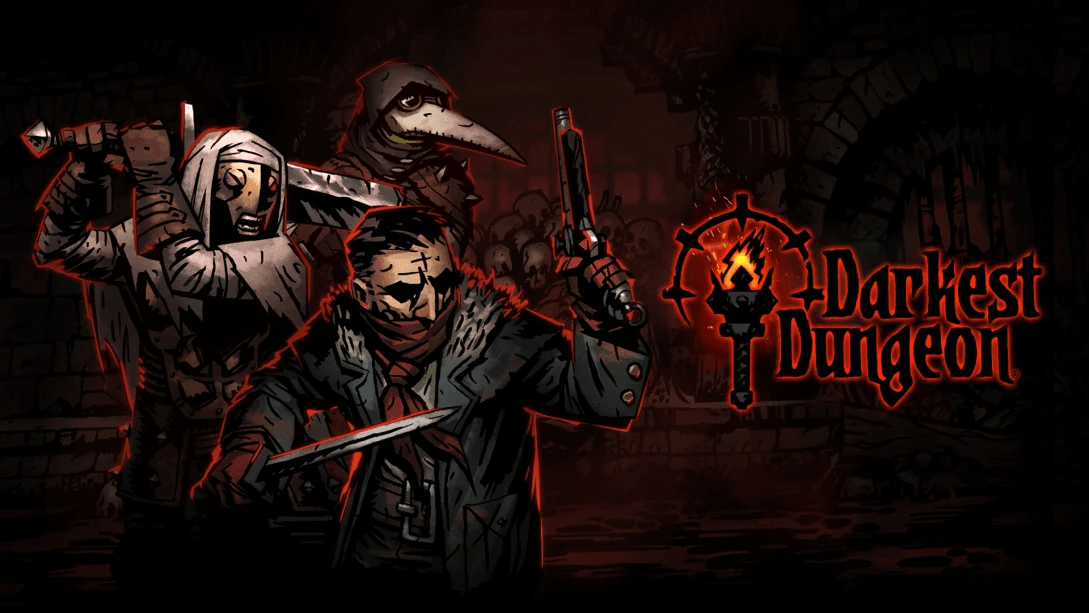
Genre: RPG
Quick Review:
Where do I even begin here? On just about every level, Darkest Dungeon shines like a spark in the void.
It bathes in Lovecraftian tropes and themes without feeling derivative or overly chiche. It’s undeniably set in the Mythos, but still tells its own story. The art style is equal parts creepy and cartoony—and always a pleasure to look at. It offers deep and strategic gameplay with wonderfully complex mechanics (even without the DLC!). It’s creepy as all get-out—it actually elicits fear and discomfort, as a horror game (especially a Lovecraftian horror game) should do. Its structure and gameplay loops are cleverly designed to encourage bonding your favorite characters while they’re frequently and mercilessly killed off. The character progression system is masterfully implemented, with characters getting stronger and nuttier the longer they trek through the dark.
Oh, and this game is HARD, making your every choice agonizing and nerve-wracking. You’ll regularly make difficult decisions and question your choices all the way down to the Darkest Dungeon. If you make it that far, that is. Death is your constant companion on this journey, and he’s not the most considerate travel buddy.
I’d say more, but I highly recommend going into this one blind, so I’m holding back a bit here. But take my word for it—Darkest Dungeon is a rare breed of games that succeed in being a great Lovecraftian game and a great game, full stop. If you enjoy spooky, strategically rich, masterfully-designed RPGs that understand what being Lovecraftian means, I can’t recommend this game highly enough. It’s my favorite of the batch.
Score: 10 out of 10
Sunless Sea + Sunless Skies
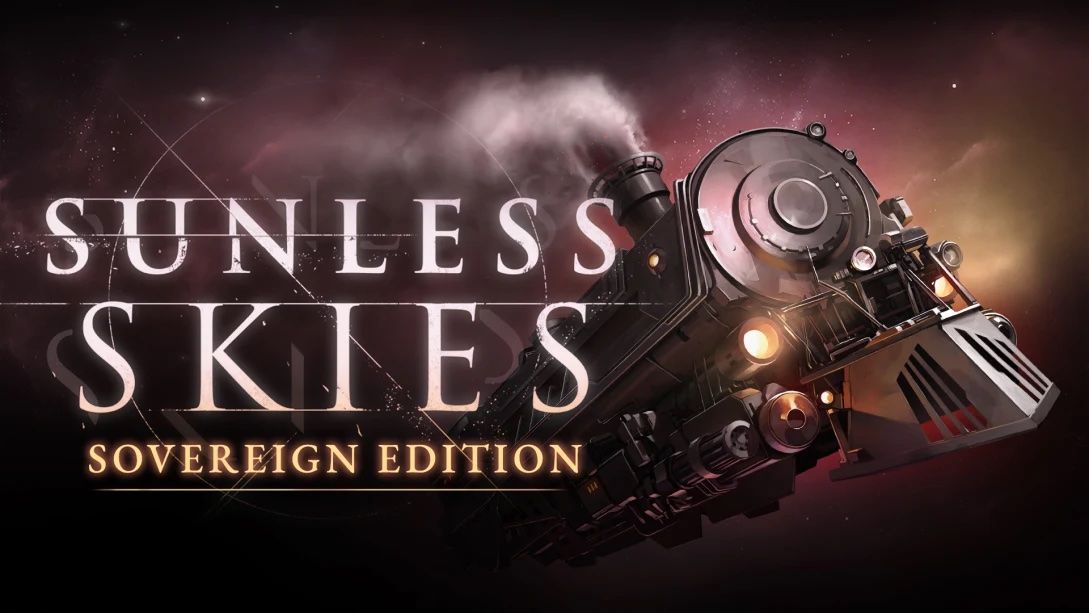
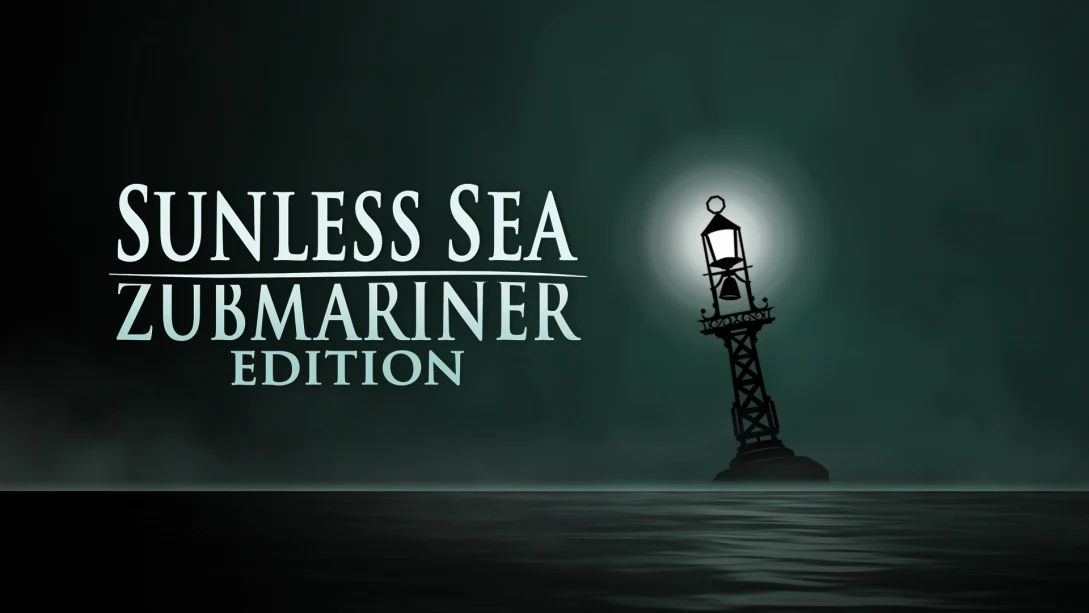
eShop Purchase Links: Sunless Sea | Sunless Skies
Genre: Adventure/RPG
Quick Review: Here are two more examples of the limitless potential stories gain when they defy convention. In terms of both gameplay and narrative, Sunless Sea and Sunless Skies elude categorization while still remaining recognizably rooted in their established genres.
From a gaming perspective, these are clearly adventure games… but they’re unlike any other adventure game out there. They both emphasize exploration, particularly in the top-down overworld (where combat also takes place), but actual story progression occurs entirely through text (usually when docked at a port/trainyard). In a way, you could describe each of them as a blend of Choose-Your-Own-Adventure-style visual novels and rudimentary arcade ‘shmups, with a splash of basic, RPG-style character progression.
Narratively, the Sunless games both start from a strange premise, and everything only gets more bonkers from there. Both are set in an alternate-reality Victorian England where Elder Gods and the sinister cults that worship them are not only routine, but wholly unremarkable. What’s weird in our world is mundane here, and vice-versa.
These games evoke an almost oppressively eerie tone. Eldritch beings might be more commonplace, but that doesn’t make them any less menacing here than in Lovecraft’s universe. Many overambitious explorers succumb to terror and insanity (but rarely death, curiously enough) by the Old Ones’ tentacles. Thankfully, heavy doses of very dark (and very British) humor help to blunt what would otherwise be an unrelentingly grim sojourn through the darkest unknowns.
If Charles Dickens, Monty Python, and H.P. Lovecraft had an eldritch love child that grew up reading Choose-Your-Own-Adventure books, playing Sinistar, and partying at Steampunk masquerade balls… that child would be the Sunless games. I highly recommend both.
And if I had to recommend just one? Well, it depends. Sunless Skies has a much better UI, more elaborate backgrounds, more streamlined mechanics, and more than a few quality-of-life improvements. Sunless Sea, however, feels much creepier and more traditionally “horror-like” and it’s still a fantastic game despite its sparser world and tough learning curve.
That said, if you start with Sunless Skies, you may feel slightly more lost without knowing the lore from Sunless Sea. You might also find adjusting to Sea’s UI and mechanics a tad too difficult if you’ve gotten used to Skies’ improvements and more forgiving early game. But then again, Sea is noticeably creepier and more foreboding, so playing Skies afterwards can feel underwhelming.
Really, you can’t go wrong with either game. It may just come down to whether you prefer nautical or train motifs.
(NOTE: Failbetter Games, the fine folks behind the Sunless games, also made Fallen London, a browser game set in the same universe. It serves as a quasi-prequel, if you will. Playing it isn’t required to enjoy the Sunless games, but it’s an excellent place to dive deeper into the lore. Plus, it’s free!)
Score: 9 out of 10
Tesla vs. Lovecraft
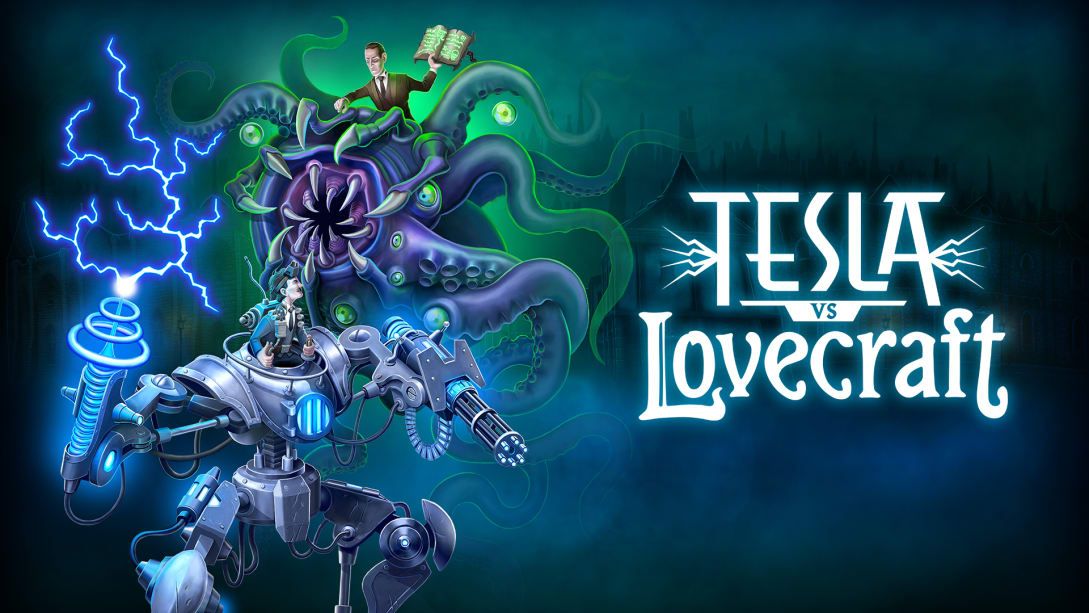
Genre: ‘Shmup
Quick Review:
This game coasts pretty far, entirely on its hilarious premise. The mere thought of two of geekdom’s highest patron saints facing off will grab many people’s attention (as it did mine), and zapping hordes of tentacled abominations is simply fun. It also has a strangely distinctive charm to it.
However, while Tesla vs. Lovecraft’s concept is indisputably awesome, it’s unfortunately not enough to sustain the interest of everyone who isn’t a hardcore ‘shmup junkie. In my case, the gameplay quickly became repetitive once the novelty wore off. Similar levels, similar monsters, similar weapons.
Now, this isn’t a knock on the game. No, the game itself is well-made. It’s built on an awesomely bonkers premise, it’s fast, it’s frantic, and it’s just so out there you have to appreciate the chutzpah. I’m just not a ‘shmup guy, and I never have been. Twin-stick shooters were never really my jam (neither are shooters in general), not even during the arcade era. That I stuck with Tesla vs. Lovecraft as long as I did really speaks to how well the developers executed their idea. Jokey games are always a crapshoot, and this one hit the bulls-eye.
So please understand, I’m not saying a bad game, by any means. And indeed, it starts quite strong. But there’s just not enough here that appeals to me, beyond its zany concept. If you’re a ‘shmup fiend that weilds those twin joysticks like Neo on a caffeine bender, this will likely scratch that itch. If not, this game is still worth checking out, but I’d advise you to wait until it goes on sale.
Score: 6 out of 10
The Last Door
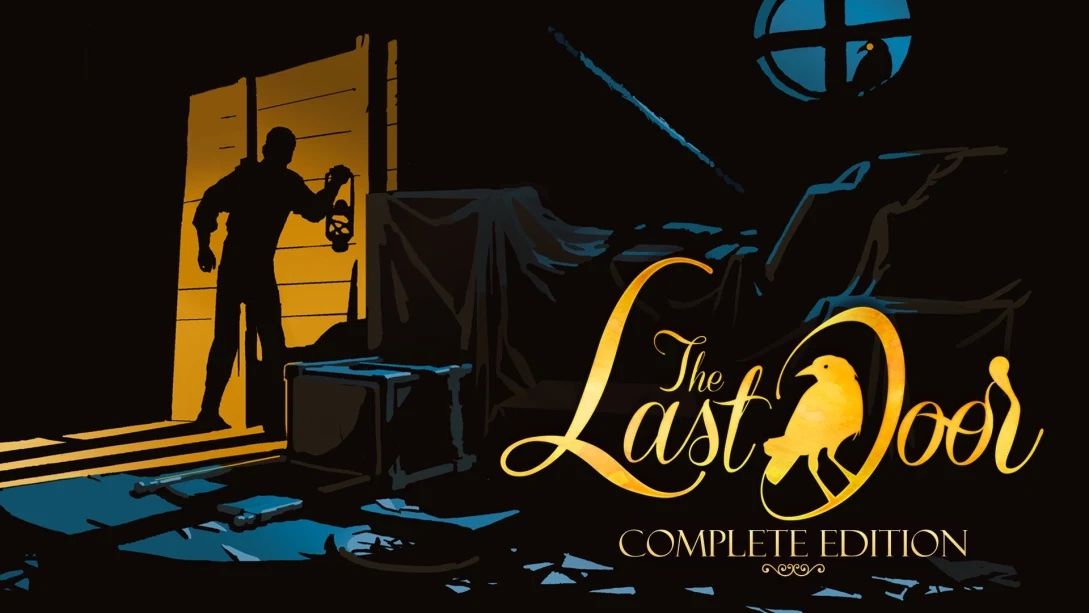
Genre: Point-And-Click Adventure
Quick Review:
At first glance, it’s easy to underestimate The Last Door. Take one look at its blocky graphics and point-and-click gameplay straight out of the 90s, and you’d be forgiven for dismissing it as tame and not scary. After all, how could something so heavily pixelated frighten anyone in any way? What kind of wimp cowers from pixels?!
But I’m here to warn you: sleeping on The Last Door would be a huge mistake. Don’t let its blocky graphics fool you—this game is tense, disquieting, unsettling, disturbing, even downright petrifying. As a horror fan, what more could you want?
Yes, I know what you’re thinking. “But it’s so pixelated! You can’t even make out their faces! There’s no way this could actually scare me!” Yeah, that’s what I thought at first. But if anything, the pixel graphics make things even scarier than they would otherwise. In the absence of enough visual information, our imaginations are left to fill in the blanks—and as a result, even The Last Door’s few jumpscares are scarier than the entirety of Call of Cthulhu and The Sinking City. Combined.
However, I must warn you—this game features something much scarier than unspeakable horrors: point-and-click adventure mechanics. Yes, this is a point-and-click game, with everything that comes with it: no action, irrationally dense puzzles, and that iconic point-and-click UI that’s annoying enough on a PC, but downright infuriating on a console.
Again, if you love adventure games (despite or because of their trappings), then this gripping title will take you for a wild ride and stick with you long after you finish. If you’re not usually an adventure gamer, then your enjoyment will depend entirely on how well you tolerate the genre’s quirks.
Score: 9 out of 10
The Sinking City
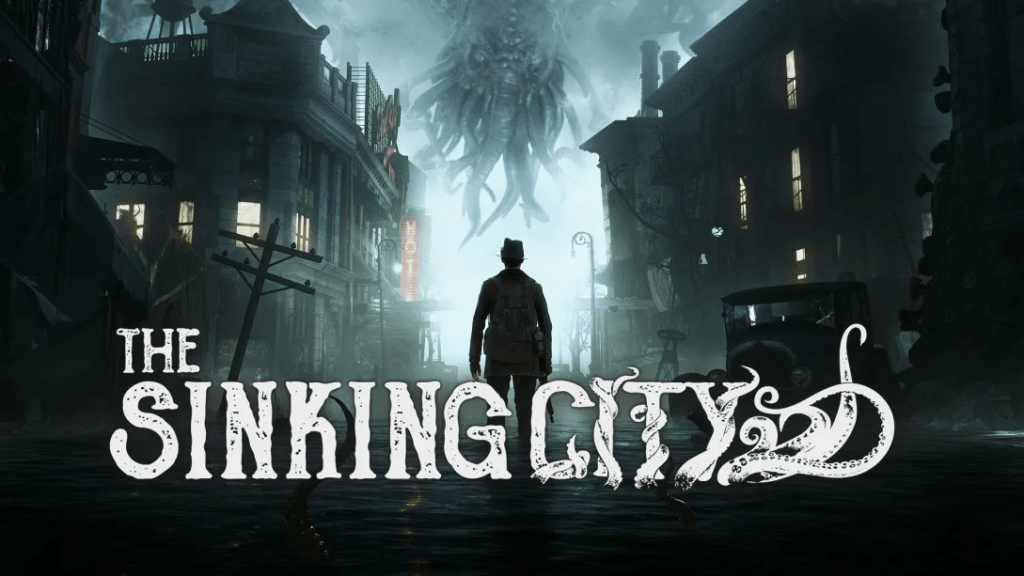
Genre: Open-World Adventure/RPG
Quick Review:
Out of all the games on this list, The Sinking City may well be the most unique. Not only does it tell an original story within the Mythos, but it also takes a decent shot at staking its claim beyond any single gaming genre.
Part open-world adventure, third-person shooter, investigative mystery, and RPG, The Sinking City offers a refreshingly novel take on the open-world genre, even in an era oversaturated with such games. It has its flaws—some of which are pretty significant—but never to the point that they supersede everything else this game does right.
What flaws, you said? I’m glad you asked. The Sinking City’s gameplay is inconsistent—some elements feel perfectly implemented, while others are hampered by clumsy mechanics or technical hiccups. Traversing the overworld often feels tedious and glacially slow. Searching the archives for clues has the rare distinction of simultaneously being easily cheeseable and maddeningly opaque.
I Fought the Game, and the Game Won
But The Sinking City‘s indisputably weakest element is (by far) its clunky, glitchy, and crummy combat. Enemy encounters play out so painfully, the combat system will drive you crazy before the sanity-crushing monsters. Lowering the combat difficulty and running from enemies is usually, with very few exceptions, a better strategy (and more fun) than “fighting” them.
The Sinking City‘s combat is clearly an afterthought, and the game design all but shouts this from the drydocks. Ammo and resources remain scarce throughout most of the main story, and the game outright tells you to run away from monsters instead of wasting bullets on them. There are instances where advancing the story requires you to kill a few monsters, but these sequences are (thankfully) rare enough to not sour the rest of the game.
Fortunately, combat isn’t central to The Sinking City, which may disappoint those expecting more action (Resident Evil, this is not). Still, this prevents combat—again, The Sinking City‘s weakest element—from smothering the rest of the game.
But the flaws don’t stop there.
Artifical Un-Intelligence
NPCs have very little variety, in every possible meaning of the term. Character models and animations are recycled shockingly often, even for notable NPCs, which becomes distracting even before you consciously connect the dots. You can’t speak with most NPCs, and the ones you can converse with tend to have similarly recycled personalities.
Furthermore, NPCs have no set routines, schedules, or “lives” of their own, which is rare for today’s open-world games. The Sinking City‘s NPCs look, and feel, like window dressing for the (otherwise brilliant) setting, and they only marginally make the city feel more “alive.” You can, however, attack and kill almost any NPC—what that says about the developers, I’d rather not know.
The Cliché of Cthulhu
The Sinking City’s writing and story, while solid, also reveal one of the game’s biggest ironies. For a title that goes to such great lengths to be its own thing—from its impressively dense open world and genre-bending gameplay to its entirely original story, setting, and characters—it leans surprisingly hard into Lovecraftian cliches.
This is also true of The Sinking City‘s gameplay (complete with a mandatory sanity meter!), but it’s most evident in the story. The protagonist is… let’s see here… *checks notes*… a hardboiled private investigator who fought during WW1 and is tormented by chronic nightmares that intensify as he increasingly loses his grip on reality. Hmmm… I don’t think I’ve seen that one before.
But wait, there’s more! One of your biggest antagonists is… hold on… *checks archive*… a secretive and sinister cult that worships a dark god who could swat humanity away as casually and effortlessly as we would a mosquito. Gee… how novel.
Finally, the setting—though impressive in many other ways—also seems vaguely familiar. This game takes place in… hold on, let me look this up… *checks Google*… an isolated town in rural Massachusetts, whose residents distrust outsiders and harbor sinister secrets, and which also happens to house several man-eating, sanity-breaking, excessively-tentacled monstrosities. Sigh.
You get the picture. There are many excellent and original ideas in The Sinking City, but it uses cliches as a narrative crutch far too often for… wait, is that a statue of Cthulhu?! Goddamnit…!
And look, I get it; The Sinking City is obviously meant to pay homage to Lovecraft’s work. Of course it’s going to include some well-known genre cliches, tropes, and archetypes. It comes with the genre.
But there’s so much more to Lovecraft’s canon than Cthulhu and Innsmouthers. Not every Mythos protagonist is a PI. Eldritch beings and cults aren’t unique to Massachusetts. And far too many of Lovecraft’s stories remain unexplored in popular media. Why not shine a light on those, instead? And I know the developers are aware of these works—the game’s treasure trove of deep-cut references shows just how much its creators know about Lovecraft’s entire body of work.
Elementary, My Dear Yith
Anyway, it probably sounds like I hate the game. I do not! In fact, this is one of the best Lovecraftian games out there. I realize that’s a laughably low bar to clear, but this game really does succeed in so many areas.
As a PI, most of your missions involve solving a mystery of some sort. Fortunately, Frogwares already has the highly-acclaimed Sherlock Holmes series under their belts, and The Sinking City‘s investigative mechanics—heavily based on those games—are generally solid. The mysteries and puzzles themselves can prove tough to crack… but praise Dagon, not because of the incomprehensible cloud-cuckoo logic that often plagues adventure game puzzles. The solutions to these cases are logically sound and easy to arrive at, once you have the information you need—the challenge comes from getting that information.
This is because the game does not hold your hand beyond introducing key mechanics. Where do you go? Who do you speak to? What do you research? That’s for you to figure out. And then add your own waypoint to the map. And after that, figure out which clues are actually relevant. It’s a wonderfully refreshing challenge.
And even when you finally piece the evidence together, solutions are rarely clean-cut. The Sinking City revels in moral ambiguity, and you’ll frequently need to choose between two equally gray actions, each based on incomplete information, to progress the story. And you’ll be second-guessing your choices long after you make them.
The story also deserves more credit, despite the cliches. The game deftly references events from several Lovecraft stories to weave entirely new types of plot thread, unexplored themes, and unanswered questions. One of The Sinking City‘s boldest and most admirable narrative innovations is how it unflinchingly wrestles the eldritch elephant in Lovecraft’s world: his racism. The degree to which the game succeeds in this task remains up for debate, and only time will definitely tell. But it’s a noble attempt.
Sinking City, Rising Setting
All that’s well and good, but The Sinking City‘s biggest selling point, its best-executed element, and its most significant contribution to the Mythos has to be—by far— the game’s superb open-world setting.
The Sinking City takes place almost entirely in the fictional city of Oakmont, a Lovecraft Country backwater steeped in decay, xenophobia, and abject misery. And that was before an otherworldly event flooded the town, rendering entire neighborhoods impassable, cutting Oakmont off from the world, and unleashing swarms of inhuman horrors (and a plague of insanity, to spice things up) onto the doomed city. Six months later, when our protagonist arrives, the waters haven’t subsided. Hence the name, The Sinking City. Get it?
The fine folks at Frogwares have talked about how much research they put into creating this setting, and it shows. The CEO even studied architecture while researching the game! The team dove headfirst into several cultural, architectural, sociological, and historical rabbit holes—all to better understand how a city like Oakmont would’ve organically developed and grown from the colonial era to the early 20th Century.
As a result, Oakmont is one of the most believable fictional settings in the Lovecraftian subgenre, the open-world genre, and possibly video games as a whole. From the street names to the brickwork on individual buildings, all of Oakmont’s details feel realistic. Different structures have their own “flairs” and personalities. And despite the game’s (thematically appropriate) grayness, each neighborhood feels unique. This is all the more impressive when you learn the developers created the whole city from scratch.
While navigating through Oakmont can feel slow and tedious, especially before unlocking enough fast travel points, the developers very much intended this—and the sooner you accept and get used to the pacing, the more enjoyable exploring this world becomes. Oakmont is a fascinating place that simply beckons you to unearth its sordid history and unknowable secrets. Exploring its streets and canals remains delightful throughout the game—and by the time you complete the story, you’ll be as familiar with the city’s labyrinthine thoroughfares as any local.
Lovecraftian Gaming’s High-Water Mark
So, despite its flaws, The Sinking City is an easy recommendation for just about anyone. The lack of action will undoubtedly disappoint some, but if you can live with that, you’re going to love your time exploring Oakmont. You’ll appreciate the creepy atmosphere and spend countless hours exploring the hauntingly beautiful city. Furthermore, the story is self-contained enough for even Lovecraft neophytes to follow effortlessly. Lovecraft diehards, meanwhile, will also have a blast appreciating the game’s plentiful references and sharing in the developers’ palpable reverence for its source material. This tribute, while not without flaws, is nevertheless a bold, innovative, and unsettling experience—one that (finally!) raises the bar for future Lovecraftian video games.
Score: 9 out of 10
Conarium
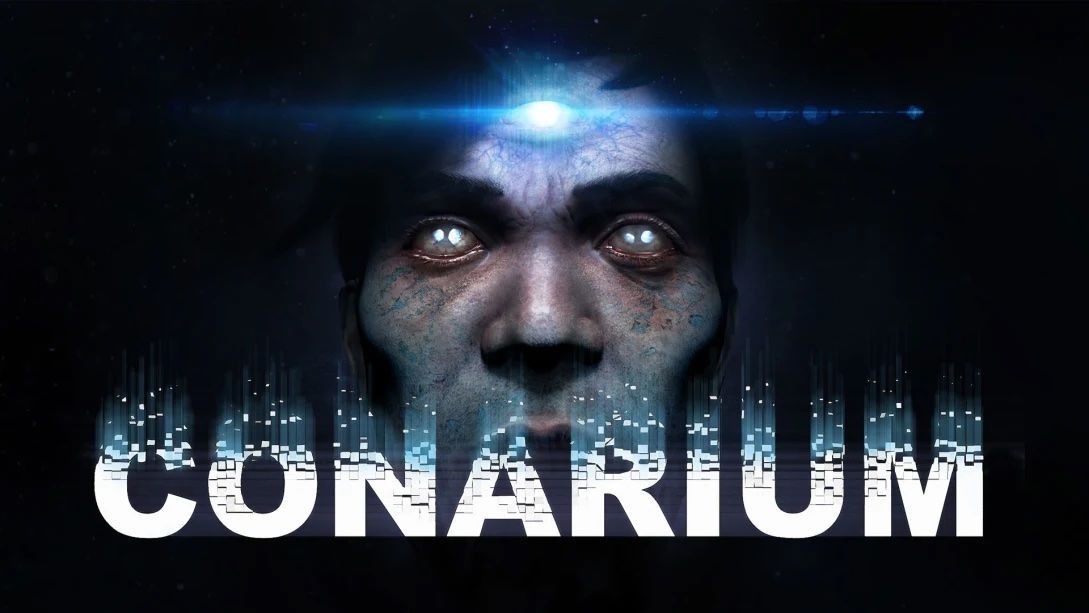
Genre: Walking Simulator / First-Person Adventure
Quick Review:
This game is…OK, I guess. Everything about the experience is basic. I hate describing a game as a “Walking Simulator,” but in Conarium‘s case, it’s quite literal. There’s really not much gameplay beyond walking around, examining things, opening doors, entering rooms, leaving rooms, and watching spooky cutscenes. Every once in a while, you’ll need to solve a puzzle or survive a chase sequence—but none of these shakeups present any real challenge.
The graphics are clean and polished, and the setting’s appropriately spooky… at least in the beginning. Then it quickly becomes mundane and monotonous. Like I said: basic.
The story’s somewhat better. The narrative hits all the right beats, and it’s got all the makings of a worthy At the Mountains of Madness sequel. The writing, on the other hand? Not so much. It consists almost entirely of purple prose, with heaps of unbelievably sloppy translation/localization on top. The end result is comically bad (even by indie standards) and constantly breaks immersion.
Granted, not everyone’s a good writer. But that’s why service providers exist. That’s the very foundation of commerce—if you struggle with performing a task (or just don’t want to), just hire someone who’s good at it and let them do it. And get this: professional writers, narrative designers, and localization editors are a thing. Why not pay one to polish up your script? After all, studios already do that with designers, composers, and developers.
And I can tell that Conarium‘s developers didn’t skimp on Conarium‘s graphics or sound design, because they’re both excellent. But bad writing is just as immersion-breaking as bad graphics or bad sound. They each have the same effect: alienating your player base. So why couldn’t the team bring on a writer, or an editor? For that matter, why do so many studios insist on putting out horribly-written games? Does nobody know you can hire writers to work on games? I know for a fact we don’t charge nearly as much as most designers, or any developer.
I mean, just look at these lovely (and relatively tame) examples (possible spoilers below):
“All of them are now vaguely mumbling in their sleep, like they are chanting something, but the sounds are not conscious.”
Or…
“We seem to be continuing this grave and serious conversation again and again, but I still can’t remember the contents.”
But wait, there’s more!
“Every time I pass into a state of dormancy, somehow, I can explore while I am dreaming the vistas of grandeur; an alien prospect in unnatural disposition, so vividly expressing the outer extent of this world I have yet to discover. If only I was endowed with the artistic skill to describe my visions…” [ED: Yes, if only you were…]
Come on, folks. Who actually talks like this? And yes, I know that Lovecraft himself also struggled with purple prose. But you don’t have to recreate every aspect of his work. And I agree that bad writing is funny, but this writing’s supposed to scare me. Do better, y’all!
That said , I will give credit where credit is due. Despite its flaws, Conarium succeeds in creating a creepy atmosphere that elicits the right kind of dread—which, in any Lovecraftian game, is ultimately what matters most. That this is an original story, while still being set within the Mythos, also deserves credit. Yes, Conarium‘s plot follows a very similar path to At the Mountains of Madness, and having read it will help you follow the game better, but Conarium‘s story is different enough to feel fresh. Combine this with the extra layer of fear that horror games provide, and you end up with a pretty decent cosmic horror tale.
But that’s the rub… it’s just decent. Not terrible, but not exactly good, either (sound familiar?). I’m honestly hard-pressed to recommend this to most gamers (unless it’s on sale). But suppose you’re a hardcore Lovecraft fan who’s absolutely fiending for a Lovecraft game, any Lovecraft game (believe me, I know the feeling). In that case, Conarium provides a reasonably engaging, if mostly unremarkable, five-hour romp through the frozen depths of madness.
Score: 5.5 out of 10
Cthulhu Saves Christmas
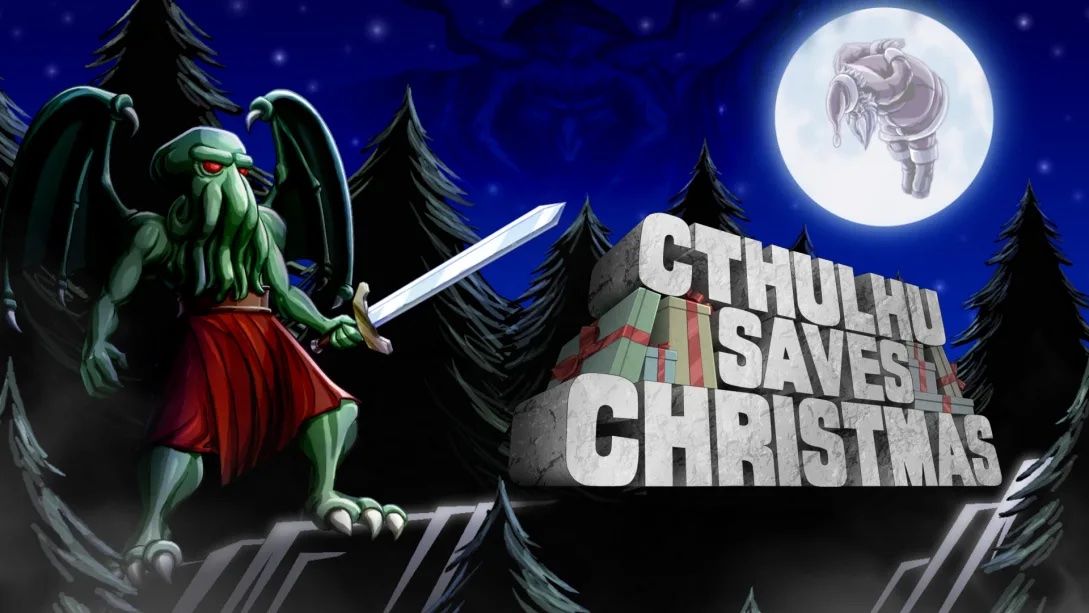
Genre: RPG
Quick Review: Exactly what it says on the tin. Cthulhu, the Mythos’ namesake, and its most iconic monster, embarks on a quest to save Christmas so he can get his powers back. So that he can then destroy the world himself (if you thought Cthulhu would ever operate from any even remotely altruistic motive, then oh sweet summer child, you’ve either never read Lovecraft or are reading him wrong).
This is a standard, turn-based JRPG that, when combined with its pixel graphics, wouldn’t feel out of place in the 16-bit era (but, thankfully, without any grinding). This will either be fine with you or drive you mad from the revelation—but either way, I can’t imagine Cthulhu Saves Christmas‘ gameplay is one of its big selling points.
No, this game’s biggest draw is in its zany premise, along with its sharp writing—both of which propel Cthulhu Saves Christmas to a level far beyond any it has any right achieving.
The concept alone is enough to elicit a chuckle, and it never gets old. But this game’s witty and self-aware writing truly elevates Cthulhu Saves Christmas from a two-bit, meme-y “joke” game to a consistently funny parody of the Mythos and its trappings, tropes, and cliches—not to mention Santa Claus and plenty of other wintery characters from world folklore.
The game also serves up plenty of meta, fourth-wall-breaking jabs at gaming culture, anime, and fandom in general. Cthulhu Saves Christmas never takes itself seriously. Sure, it’s a very basic JRPG based around a joke premise, but it never pretends to be anything else. And half the fun comes from being in on the same joke, laughing with and at this game in equal measure.
Alas, Cthulhu Saves Christmas is a quick game that’s all over in a handful of hours. But, paradoxically, the game’s short length works in its favor—it prevents the gameplay from becoming too boring, or the jokes too stale. In short, it’s just short enough to never wear out its welcome. (See what I did there?)
All in all, Cthulhu Saves Christmas is a genuinely hilarious send-up of Lovecraftian horror, all its sacred (eldritch) cows, JRPGs, and the holiday season more broadly. It had me laughing all the way through, and if you’re a fan of any of the things I just mentioned, it’ll do the same for you.
Score: 9 out of 10
Did I Miss Anything?
So, there you have it! Every Lovecraftian game on Switch, reviewed! At least, I think that was all of them…
If I missed any games, please let me know at jay@levelupmedia.com — I’ll be updating this list fairly regularly (at least yearly) as more of these games are released and/or come to my attention.
Only Nintendo Switch recommendations, please! I have no interest, not will I ever have an interest, in putting myself through every last miserable and blasphemous digital abomination with a “Lovecraftian” label.
Stay safe, stay spooked, and have a Happy Halloween!

